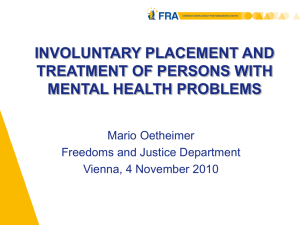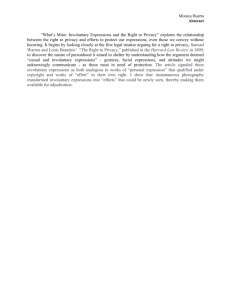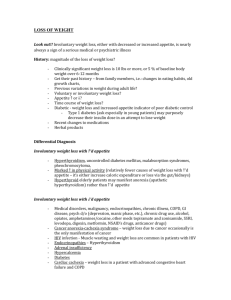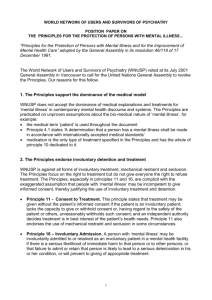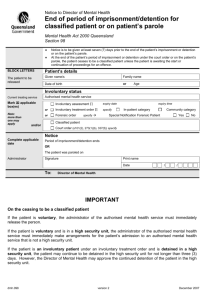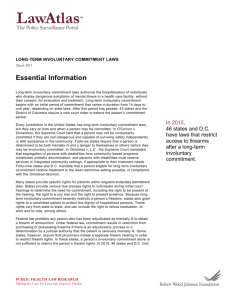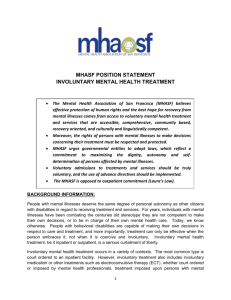Approach to the patient with weight loss
advertisement
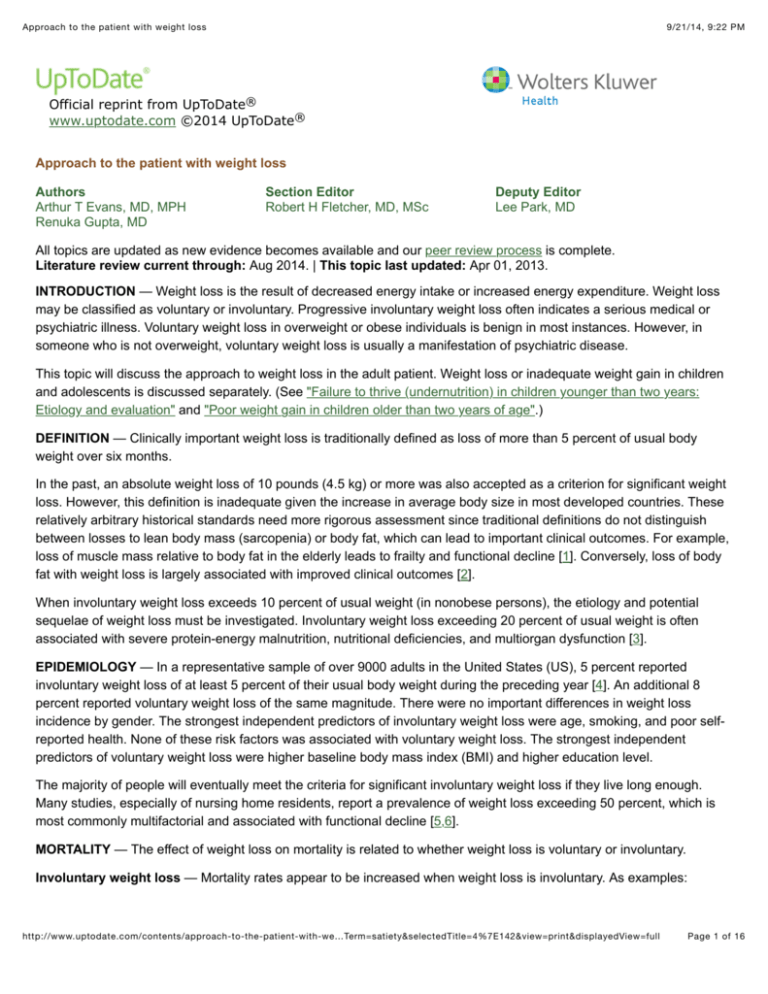
Approach to the patient with weight loss 9/21/14, 9:22 PM Official reprint from UpToDate® www.uptodate.com ©2014 UpToDate® Approach to the patient with weight loss Authors Arthur T Evans, MD, MPH Renuka Gupta, MD Section Editor Robert H Fletcher, MD, MSc Deputy Editor Lee Park, MD All topics are updated as new evidence becomes available and our peer review process is complete. Literature review current through: Aug 2014. | This topic last updated: Apr 01, 2013. INTRODUCTION — Weight loss is the result of decreased energy intake or increased energy expenditure. Weight loss may be classified as voluntary or involuntary. Progressive involuntary weight loss often indicates a serious medical or psychiatric illness. Voluntary weight loss in overweight or obese individuals is benign in most instances. However, in someone who is not overweight, voluntary weight loss is usually a manifestation of psychiatric disease. This topic will discuss the approach to weight loss in the adult patient. Weight loss or inadequate weight gain in children and adolescents is discussed separately. (See "Failure to thrive (undernutrition) in children younger than two years: Etiology and evaluation" and "Poor weight gain in children older than two years of age".) DEFINITION — Clinically important weight loss is traditionally defined as loss of more than 5 percent of usual body weight over six months. In the past, an absolute weight loss of 10 pounds (4.5 kg) or more was also accepted as a criterion for significant weight loss. However, this definition is inadequate given the increase in average body size in most developed countries. These relatively arbitrary historical standards need more rigorous assessment since traditional definitions do not distinguish between losses to lean body mass (sarcopenia) or body fat, which can lead to important clinical outcomes. For example, loss of muscle mass relative to body fat in the elderly leads to frailty and functional decline [1]. Conversely, loss of body fat with weight loss is largely associated with improved clinical outcomes [2]. When involuntary weight loss exceeds 10 percent of usual weight (in nonobese persons), the etiology and potential sequelae of weight loss must be investigated. Involuntary weight loss exceeding 20 percent of usual weight is often associated with severe protein-energy malnutrition, nutritional deficiencies, and multiorgan dysfunction [3]. EPIDEMIOLOGY — In a representative sample of over 9000 adults in the United States (US), 5 percent reported involuntary weight loss of at least 5 percent of their usual body weight during the preceding year [4]. An additional 8 percent reported voluntary weight loss of the same magnitude. There were no important differences in weight loss incidence by gender. The strongest independent predictors of involuntary weight loss were age, smoking, and poor selfreported health. None of these risk factors was associated with voluntary weight loss. The strongest independent predictors of voluntary weight loss were higher baseline body mass index (BMI) and higher education level. The majority of people will eventually meet the criteria for significant involuntary weight loss if they live long enough. Many studies, especially of nursing home residents, report a prevalence of weight loss exceeding 50 percent, which is most commonly multifactorial and associated with functional decline [5,6]. MORTALITY — The effect of weight loss on mortality is related to whether weight loss is voluntary or involuntary. Involuntary weight loss — Mortality rates appear to be increased when weight loss is involuntary. As examples: http://www.uptodate.com/contents/approach-to-the-patient-with-we…Term=satiety&selectedTitle=4%7E142&view=print&displayedView=full Page 1 of 16 Approach to the patient with weight loss 9/21/14, 9:22 PM In the Israeli Ischemic Heart Disease Study of over 10,000 adult men working in the civil service, those who were not dieting but nevertheless lost at least 5 kg over 5 years had an 18 percent increase in total mortality over the next 18 years [7]. The excess mortality was almost entirely explained by increased cardiovascular deaths, even after adjusting for age, baseline cardiovascular risk factors, baseline BMI, and other comorbidities. Cancer mortality was not different between those who lost weight and those who did not. The US National Health and Nutrition Examination Survey (NHANES) II Mortality Study evaluated over 5000 participants age ≥50 years, who were followed for at least 12 years [8]. Seven percent of the sample reported involuntary weight loss of 5 percent or more over six months. Prevalence increased with age and was also higher among those with obesity. Involuntary weight loss was associated with a 24 percent relative increase in mortality during the follow-up period, even among those with obesity. Mortality rates are higher for other specific populations with weight loss. Weight loss among nursing home residents predicts increased mortality, regardless of underlying diagnosis [9-12]. Voluntary weight loss — It is unclear whether voluntary weight loss in the general population is associated with reduced mortality. In prospective cohort studies, voluntary weight loss may be associated with a decrease in mortality in overweight and obese individuals [13,14]. Patients who lose weight following bariatric surgery have both decreased comorbid illness and mortality rates [15-17]. However, these studies included specific patient populations undergoing bariatric surgery and cannot be extrapolated to the general population who are losing weight through diet and exercise. (See "Short-term medical outcomes following bariatric surgery".) ETIOLOGY — There are many causes of weight loss, which are classified as voluntary or involuntary (table 1). In the absence of fever or other cause for increased energy expenditure, weight loss is predominantly due to decreased food intake. Involuntary weight loss — Progressive involuntary weight loss often indicates serious medical or psychiatric illness. Any chronic illness affecting any organ system can cause anorexia and weight loss. Endocrinopathies Hyperthyroidism — Weight loss in hyperthyroidism is due primarily to increased catabolism, but other causes include increased intestinal motility and malabsorption. Most patients have hyperphagia. Some younger patients with mild hyperthyroidism eat enough to actually gain weight. In older patients, however, hyperthyroidism often causes anorexia with accelerated weight loss. (See "Overview of the clinical manifestations of hyperthyroidism in adults".) The average weight loss in a patient with hyperthyroidism is 16 percent of usual body weight [18]. Weight gain occurs quickly with treatment. Diabetes mellitus — Uncontrolled diabetes mellitus is a common cause of weight loss with increased appetite, particularly with new-onset type 1 diabetes mellitus. There is a loss in lean body mass as well as loss of extracellular and cellular water due to the osmotic diuresis from glucosuria. The etiology of weight loss in uncontrolled diabetes is likely multifactorial, a combination of anorexia, depression, pain, malabsorption, gastroparesis, and enteropathy. Some reports describe persons who intentionally undertreat their diabetes in order to lose weight [19]. (See "Clinical presentation and diagnosis of diabetes mellitus in adults".) Although patients with poorly-controlled or undiagnosed type 2 diabetes can occasionally present with weight loss, weight gain is much more common. However, some patients with type 2 diabetes can occasionally present with diabetic neuropathic cachexia, an unusual and poorly understood syndrome characterized by profound weight loss (as much as 60 percent of body weight) and often severe neuropathic pain of the anterior thighs [20,21]. The pathophysiology is not clear, especially since there is no strong relationship between glucose control and resolution of weight loss, which http://www.uptodate.com/contents/approach-to-the-patient-with-we…Term=satiety&selectedTitle=4%7E142&view=print&displayedView=full Page 2 of 16 Approach to the patient with weight loss 9/21/14, 9:22 PM usually happens spontaneously after months or years. Other endocrine disorders — Chronic primary adrenal insufficiency often presents with significant weight loss, although other associated signs and symptoms are more prominent: dehydration, anorexia, lassitude, fatigue, and weakness. Adrenal insufficiency that is acute or due to hypothalamic or pituitary dysfunction is usually not associated with weight loss. (See "Clinical manifestations of adrenal insufficiency in adults".) Anorexia, nausea, constipation, and polyuria may account for weight loss in patients with the classic clinical manifestations of hyperparathyroidism. However, the majority of patients with primary hyperparathyroidism are asymptomatic and do not have weight loss. This was illustrated by the findings of a meta-analysis of 13 studies, which showed that patients with primary hyperparathyroidism actually weigh more than age-matched controls [22]. The hyperadrenergic state among patients with pheochromocytoma would theoretically cause weight loss with increased appetite, but only 5 percent of patients with pheochromocytomas report weight loss [23]. Gastrointestinal diseases — There are numerous mechanisms that can cause weight loss in gastrointestinal diseases: anorexia, abdominal pain, early satiety, dysphagia, odynophagia, dysmotility, diarrhea, malabsorption, chronic bleeding, chronic inflammation, chronic ischemia, obstruction, fistulas, malignancies, infections, gastrointestinal resections, and/or bypasses. In studies that examined the etiologies for involuntary weight loss, benign gastrointestinal causes accounted for 10 to 20 percent [24-27]. Malabsorption may cause weight loss with increased or normal appetite. However, celiac disease, one of the more common causes of malabsorption, usually does not present with weight loss or diarrhea in adults. More commonly, adult patients with celiac disease present with iron deficiency or other manifestations of nutritional malabsorption. (See "Clinical features and diagnosis of malabsorption".) Although inflammatory bowel disease can be associated with malabsorption, this is usually a late manifestation. The initial presentation of Crohn's disease often includes significant weight loss, but this is most likely from inflammation and poor appetite. In contrast, early ulcerative colitis usually does not present with weight loss, although marked weight loss occurs with advanced disease. When malabsorption is due to vascular insufficiency, weight loss can be associated with decreased oral intake due to intestinal angina. Mesenteric artery syndrome, however, is almost always a manifestation of weight loss and is not the cause of weight loss. (See "Superior mesenteric artery syndrome".) Malignancy — There are multiple mechanisms accounting for weight loss in patients with cancer. Anorexia and weight loss are present in over 50 percent of cancer patients at the time of diagnosis. In a study of patients with lung cancer, anorexia was associated with an average intake deficit of only 300 kcal/day [28]. This does not explain the profound weight loss in some patients with cancer cachexia syndrome. Cancer cachexia involves complex metabolic abnormalities that decrease muscle mass and appear to be mediated, at least in part, by tumor necrosis factor alpha and interleukins 1 and 6. (See "Pathogenesis, clinical features, and assessment of cancer cachexia".) Additional factors associated with weight loss in malignancy include pain, abdominal distention, nausea, vomiting, infections, dysphagia, early satiety due to hepatosplenic enlargement or malignant obstruction, hypercalcemia, malabsorption, or adverse effects of chemotherapy or radiotherapy. Studies of unexplained involuntary weight loss eventually identify malignancy as the primary cause in 15 to 35 percent of weight loss patients [29]. One prospective study of involuntary weight loss in the US found that "occult" malignancy (ie, not evident after routine studies) is very unusual, with only 1 of 59 patients diagnosed with malignancy over an extended follow-up after an initial evaluation for weight loss was negative [24]. If malignancy is the cause, there is almost always http://www.uptodate.com/contents/approach-to-the-patient-with-we…Term=satiety&selectedTitle=4%7E142&view=print&displayedView=full Page 3 of 16 Approach to the patient with weight loss 9/21/14, 9:22 PM one or more abnormality noted during the standard diagnostic evaluation, and malignancy is usually diagnosed early in the evaluation process. Thus, occult malignancy is a rare cause of unexplained weight loss. HIV and other infections — Patients with HIV infection have total daily energy expenditure similar to normal subjects [30-32]. Weight loss in patients with HIV infection is usually episodic, occurring with secondary infections or gastrointestinal diseases, and leads to a reduction in energy intake. The lethargy and fatigue that accompany infection may help maintain energy balance and weight [32]. Many chronic infections lead to involuntary weight loss. As an example, many patients with active tuberculosis experience weight loss. For reactivation tuberculosis, significant weight loss is one of the cardinal signs and symptoms. (See "Epidemiology of tuberculosis" and "Clinical manifestations, diagnosis, and treatment of extrapulmonary and miliary tuberculosis".) Chronic infection with hepatitis C virus can also cause weight loss, in addition to nausea, anorexia, and weakness. Drug therapy for hepatitis C can cause or exacerbate weight loss. (See "Clinical manifestations and natural history of chronic hepatitis C virus infection".) Advanced cardiac, pulmonary, and renal disease — Hippocrates was among the first to describe weight loss in patients with chronic heart failure (sometimes called “cardiac cachexia”). Nearly one-half of heart failure patients with New York Heart Association Class III or IV disease lose lean body mass and meet criteria for malnutrition. Weight loss in this population can be associated with anorexia, early satiety, depression, intestinal and liver congestion, and increased levels of cytokines and angiotensin II [33]. The fluid retention associated with chronic heart failure often masks the extensive loss of lean body mass. Weight loss in patients with chronic heart failure is associated with an increased mortality rate. (See "Predictors of survival in heart failure due to systolic dysfunction", section on 'Weight loss and BMI'.). Chronic weight loss with malnutrition can also occur with severe chronic lung disease and has been called the pulmonary cachexia syndrome. Estimates of cachexia in severe chronic obstructive pulmonary disease range from 30 to 70 percent [34]. Progressive weight loss can occur even with adequate caloric intake due to increased respiratory muscle work and possibly systemic inflammation. Often the weight loss is episodic, associated with exacerbations of lung disease, but without any regain in weight after recovery. Glucocorticoid treatment, systemic inflammation, and immobility contribute to the loss of muscle mass in severe lung disease. (See "Nutritional support in advanced lung disease", section on 'Metabolism and caloric intake'.) In advanced kidney disease, anorexia and other uremic symptoms usually occur when the glomerular filtration rate (GFR) drops below 15 mL/min. As with heart failure, fluid retention in advanced kidney disease often masks the true loss in lean body mass. (See "Overview of the management of chronic kidney disease in adults", section on 'Malnutrition'.) Neurologic diseases — Several neurologic illnesses can lead to weight loss, including stroke, dementia, Parkinson disease, and amyotrophic lateral sclerosis. Weight loss may be due to one or more deficits associated with these disorders, such as anorexia, altered cognition, motor dysfunction, and dysphagia. (See "Medical complications of stroke" and "Clinical manifestations of Parkinson disease" and "Clinical features of amyotrophic lateral sclerosis and other forms of motor neuron disease" and "Risk factors for cognitive decline and dementia", section on 'Obesity and body mass index'.) Systemic inflammatory disorders — There are reports of older patients with unintentional weight loss who are eventually diagnosed with giant cell (temporal) arteritis but never manifest classic signs or symptoms of the disease [35]. Psychiatric disorders — Psychiatric illness can be a common cause of involuntary weight loss, occurring in 10 to 44 percent of community-dwelling participants [25,26,36]. In addition, psychiatric disorders, particularly depression, account for 31 to 58 percent of cases of involuntary weight loss in nursing home patients [9,37,38]. The independent role of depression in weight loss is difficult to determine due to the frequency of overlapping causes, such as social isolation, http://www.uptodate.com/contents/approach-to-the-patient-with-we…Term=satiety&selectedTitle=4%7E142&view=print&displayedView=full Page 4 of 16 Approach to the patient with weight loss 9/21/14, 9:22 PM physical disabilities, dementia, dysphagia, medication/drug use, and multiple chronic diseases. (See "Unipolar depression in adults: Assessment and diagnosis".) Loss of appetite and involuntary weight loss can also occur in patients with other psychiatric disorders. During the manic phases of bipolar disorder, hyperactivity and preoccupations may interfere with normal eating patterns. In rare circumstances, patients with delusions or paranoia may develop peculiar ideations about food that lead to decreased food intake and subsequent weight loss. (See "Bipolar disorder in adults: Epidemiology and pathogenesis" and "Overview of psychosis".) Drugs — Several over-the-counter, prescription, and illicit drugs can lead to weight loss (table 1). Over-the-counter medications — There are many over-the-counter and herbal medications that can inadvertently cause patients to lose weight. A careful history is important in identifying nonprescription drug use (eg, nonsteroidal antiinflammatory drugs), herbal remedies/teas, and food additives. Prescription drugs — Weight loss is a known adverse effect of several common prescription drugs, including anticonvulsants, antidepressants, levodopa, digoxin, metformin, exenatide, liraglutide, and thyroid medication. Marked weight loss can occur after reduction or withdrawal of some antipsychotic drugs (eg, chlorpromazine, haloperidol, thioridazine, mesoridazine) [39]. Patients who experience weight loss have usually been treated for many years with high doses. The rapid weight loss and ill appearance of cachexia due to antipsychotic drug withdrawal are quickly reversed, however, by resuming the original dose of antipsychotic medication. Weight loss with withdrawal of newer antipsychotic agents occurs infrequently. Substance abuse — Weight loss occurs commonly with several drugs of abuse: Many alcohol-dependent patients consume most of their calories from alcohol and thus have several nutritional deficiencies in addition to weight loss. However, weight loss in patients with alcoholic cirrhosis may be masked by secondary ascites and fluid retention. As many as 40 percent of chronic cocaine users experience weight loss, anorexia, and sleep disturbances. (See "Cocaine use disorder in adults: Epidemiology, pharmacology, clinical manifestations, medical consequences, and diagnosis".) Opiates directly inhibit the appetite center, decrease gastrointestinal motility, and can cause hyperalgesia with chronic abdominal pain. (See "Opioid use disorder: Epidemiology, pharmacology, clinical manifestations, course, screening, assessment, and diagnosis".) Amphetamines promote release of catecholamines from presynaptic nerve terminals which can decrease appetite and increase basal metabolism. Withdrawal from chronic marijuana use can cause a syndrome that includes anorexia, weight loss, irritability, and strange dreams [40]. Heavy tobacco use leads to weight loss, whereas weight gain occurs with smoking cessation. Voluntary weight loss — Many persons lose weight voluntarily. Weight loss should be encouraged in overweight and obese patients who desire to lose weight, as long as there are no concerning symptoms or signs present. Evaluation and management of obesity are discussed elsewhere. (See "Obesity in adults: Prevalence, screening, and evaluation" and "Obesity in adults: Overview of management".) In patients who are of normal weight or underweight, obsession with being overweight leads to weight loss as a result of http://www.uptodate.com/contents/approach-to-the-patient-with-we…Term=satiety&selectedTitle=4%7E142&view=print&displayedView=full Page 5 of 16 Approach to the patient with weight loss 9/21/14, 9:22 PM decreased food intake, excessive exercise, self-induced vomiting, drug/herbal medication use, and/or behaviors suggestive of bulimia/anorexia nervosa. (See "Eating disorders: Overview of epidemiology, diagnosis, and course of illness".) Some patients with personality disorders and dependent tendencies may voluntarily decrease food intake or use other measures to lose weight as a mechanism for attention seeking. (See "Factitious disorder and Munchausen syndrome".) In addition, some persons have vocations that require them to be very lean (eg, long distance runners, models, ballet dancers, gymnasts). Some persons who engage in intense training must increase their intake of calories considerably to maintain their weight and muscle mass. Increased food intake is not always sufficient to maintain body weight, resulting in transient or persistent weight loss. (See "Exercise physiology".) EVALUATION — Given the broad differential diagnosis of involuntary weight loss (table 1), there is no single diagnostic approach for all patients. The work-up should be individualized, based on findings from the patient's history and physical examination (algorithm 1). A standard evaluation of patients with unexplained weight loss will yield a diagnosis in the majority of cases (72 to 95 percent) [5,24,29,41-43]. If no abnormality is identified after initial evaluation, the patient should be reassessed in one to six months. Currently, there are no widely-accepted guidelines for the clinical evaluation of weight loss. History — Qualitative judgments by patients about the magnitude of their weight loss are often unreliable. In a prospective study of involuntary weight loss, only 50 percent of patients reporting weight loss had true weight loss [24]. Therefore, in documenting weight loss, it is important to obtain previous weight records and, if not available, to query family members about the patient's weight history, including usual weight prior to the period of weight loss. As part of the history it is important to determine the duration and pattern of weight loss, including past fluctuations in weight and whether weight loss is progressive or stabilized. Weight loss in a person whose weight has been stable for many years and weight loss that is progressive are more worrisome and require more immediate follow-up. Other factors to consider include intention to lose weight, changes in appetite, caloric intake, and physical activity. Furthermore, the interviewing clinician should elicit medical, psychological, and functional factors associated with poor food intake. The nine D's associated with weight loss may help elicit these factors, particularly in the elderly [43,44]: Dentition Dysgeusia Dysphagia Diarrhea Depression Dementia Disease Dysfunction Drugs A thorough review of systems is necessary if the etiology remains uncertain after the above questioning. Physical examination — Several prospective studies have verified the importance of a complete physical examination in evaluating unexplained weight loss [24,42,45]. The clinician should assess the overall appearance, affect, skin changes (eg, melanoma or spider angiomata), presence of lymphadenopathy, cardiopulmonary status, hepatosplenomegaly, abdominal mass, breast/prostate abnormalities, rectal examination with stool hemoccult, and any neurologic deficit. In observational studies, abnormal physical findings were common among those with malignancy [25,42,45]. As an example, in a prospective cohort study of 101 patients, 12 out of 22 patients (55 percent) diagnosed with cancer as the cause of weight loss had an abnormal physical examination finding [42]. In another study, abnormal http://www.uptodate.com/contents/approach-to-the-patient-with-we…Term=satiety&selectedTitle=4%7E142&view=print&displayedView=full Page 6 of 16 Approach to the patient with weight loss 9/21/14, 9:22 PM physical findings were found among 59 percent of patients who were diagnosed with either malignancy or other organic causes of weight loss [45]. Conversely, abnormal physical findings were present in only 3 percent of those diagnosed with a psychiatric disorder or who remained undiagnosed after a thorough evaluation and follow-up. Diagnostic testing — In patients with positive findings on history or physical examination, further testing should be focused on confirming the suspected diagnosis. When the history and physical examination do not indicate a likely diagnosis, a basic diagnostic evaluation should include: Laboratory testing: complete blood count with differential, chemistries (electrolytes, glucose, calcium, renal and hepatic function, thyroid stimulating hormone), hemoglobin A1c, urinalysis, stool hemoccult, and erythrocyte sedimentation rate (ESR) or C-reactive protein (CRP) (algorithm 1). Diagnostic imaging: chest radiograph We do not recommend whole body CT scanning in the initial workup, although CT scanning may be indicated based on history or physical examination. Further studies should be based on results of these initial tests. Despite an appropriate initial evaluation, a clear cause for weight loss is often not found. Watchful waiting for one to six months is preferable to a battery of testing with low diagnostic yield. As organic disease is rarely found in patients with a normal physical examination and initial diagnostic testing, a waiting period of one to six months is unlikely to result in an adverse outcome [5,24,46]. On follow-up, careful attention should be paid to dietary history, possibility of psychosocial causes, surreptitious drug intake, and new manifestations of occult illness. Clinical prediction rules — There are no clinical prediction rules or standardized guidelines that have been externally validated or widely accepted for the clinical evaluation of weight loss. One clinical prediction rule to identify malignancy in patients with unexplained involuntary weight loss was prospectively validated at the same site in a group of 328 patients (in whom malignancy was identified in 35 percent) [47]. The independent predictors of malignancy included elevated levels of alkaline phosphatase and LDH, low albumin, leukocytosis, and advanced age (table 2). This clinical prediction rule requires external validation prior to widespread use. In a prospective cohort study of 101 patients, 22 of 22 patients with malignancy had an abnormal laboratory test, with Creactive protein, hemoglobin, lactate dehydrogenase, and albumin having the highest sensitivities [42]. Abnormal abdominal ultrasound and chest radiograph had lower sensitivities, 45 and 18 percent, respectively. However, all of these diagnostic tests were also abnormal, but to a lesser extent, among patients with non-malignant organic disease. Thus, there is no general diagnostic test or group of tests that appears to be specific for malignancy. MANAGEMENT — The management of weight loss depends on the specific underlying cause. Treatment strategies include, but are not limited to, pharmacologic therapy (eg, infections, endocrinopathies), surgery/radiation (eg, malignancy), behavioral therapy (eg, depression, anorexia nervosa), removal of offending agents (eg, ephedra, laxatives), and/or nutritional support (eg, dementia, dysphagia). Treatments for specific causes of weight loss are discussed in detail elsewhere. (See "Pharmacologic management of cancer anorexia/cachexia" and "Management of tissue wasting in patients with HIV infection" and "Geriatric nutrition: Nutritional issues in older adults" and "Failure to thrive in elderly adults: Management".) SUMMARY AND RECOMMENDATIONS Clinically-important weight loss is traditionally defined as loss of more than 5 percent of usual body weight over six months. (See 'Definition' above.) http://www.uptodate.com/contents/approach-to-the-patient-with-we…Term=satiety&selectedTitle=4%7E142&view=print&displayedView=full Page 7 of 16 Approach to the patient with weight loss 9/21/14, 9:22 PM There are many causes of weight loss, which are classified as voluntary or involuntary (table 1). Progressive involuntary weight loss often indicates serious medical or psychiatric illness. (See 'Involuntary weight loss' above.) In patients who are of normal weight or underweight, fear of weight gain can lead to weight loss through decreased food intake, excessive exercise, self-induced vomiting, and/or drug/herbal medication use. (See 'Voluntary weight loss' above.) Most large cohort studies have found that involuntary weight loss is associated with increased mortality. (See 'Mortality' above.) The work-up of a patient with weight loss should be individualized, based on findings from the patient's history and physical examination (algorithm 1). (See 'Evaluation' above.) When the history and physical examination do not indicate a likely diagnosis, a basic diagnostic evaluation should include a complete blood count with differential, chemistries, hemoglobin A1c, urinalysis, stool hemoccult, erythrocyte sedimentation rate or C-reactive protein, and chest radiograph. Further studies should be based on results of these initial tests. If no abnormality is identified after initial evaluation, the patient should be reassessed in one to six months. (See 'Diagnostic testing' above.) Use of UpToDate is subject to the Subscription and License Agreement. REFERENCES 1. Bales CW, Ritchie CS. Sarcopenia, weight loss, and nutritional frailty in the elderly. Annu Rev Nutr 2002; 22:309. 2. Brinkworth GD, Noakes M, Buckley JD, Clifton PM. Weight loss improves heart rate recovery in overweight and obese men with features of the metabolic syndrome. Am Heart J 2006; 152:693.e1. 3. Bistrian BR. Nutritional Assessment. In: Textbook of Medicine, Saunders, Philadelphia. 4. Meltzer AA, Everhart JE. Unintentional weight loss in the United States. Am J Epidemiol 1995; 142:1039. 5. Bouras EP, Lange SM, Scolapio JS. Rational approach to patients with unintentional weight loss. Mayo Clin Proc 2001; 76:923. 6. Moriguti JC, Moriguti EK, Ferriolli E, et al. Involuntary weight loss in elderly individuals: assessment and treatment. Sao Paulo Med J 2001; 119:72. 7. Yaari S, Goldbourt U. Voluntary and involuntary weight loss: associations with long term mortality in 9,228 middleaged and elderly men. Am J Epidemiol 1998; 148:546. 8. Sahyoun NR, Serdula MK, Galuska DA, et al. The epidemiology of recent involuntary weight loss in the United States population. J Nutr Health Aging 2004; 8:510. 9. Morley JE, Kraenzle D. Causes of weight loss in a community nursing home. J Am Geriatr Soc 1994; 42:583. 10. Murden RA, Ainslie NK. Recent weight loss is related to short-term mortality in nursing homes. J Gen Intern Med 1994; 9:648. 11. Flacker JM, Kiely DK. A practical approach to identifying mortality-related factors in established long-term care residents. J Am Geriatr Soc 1998; 46:1012. 12. Flacker JM, Kiely DK. Mortality-related factors and 1-year survival in nursing home residents. J Am Geriatr Soc 2003; 51:213. 13. Wannamethee SG, Shaper AG, Lennon L. Reasons for intentional weight loss, unintentional weight loss, and mortality in older men. Arch Intern Med 2005; 165:1035. 14. Gregg EW, Gerzoff RB, Thompson TJ, Williamson DF. Intentional weight loss and death in overweight and obese http://www.uptodate.com/contents/approach-to-the-patient-with-we…Term=satiety&selectedTitle=4%7E142&view=print&displayedView=full Page 8 of 16 Approach to the patient with weight loss 9/21/14, 9:22 PM U.S. adults 35 years of age and older. Ann Intern Med 2003; 138:383. 15. Sjöström L, Narbro K, Sjöström CD, et al. Effects of bariatric surgery on mortality in Swedish obese subjects. N Engl J Med 2007; 357:741. 16. Adams TD, Gress RE, Smith SC, et al. Long-term mortality after gastric bypass surgery. N Engl J Med 2007; 357:753. 17. Perry CD, Hutter MM, Smith DB, et al. Survival and changes in comorbidities after bariatric surgery. Ann Surg 2008; 247:21. 18. Hoogwerf BJ, Nuttall FQ. Long-term weight regulation in treated hyperthyroid and hypothyroid subjects. Am J Med 1984; 76:963. 19. Rodin GM, Daneman D. Eating disorders and IDDM. A problematic association. Diabetes Care 1992; 15:1402. 20. Neal JM. Diabetic neuropathic cachexia: a rare manifestation of diabetic neuropathy. South Med J 2009; 102:327. 21. Blau RH. Diabetic neuropathic cachexia. Report of a woman with this syndrome and review of the literature. Arch Intern Med 1983; 143:2011. 22. Bolland MJ, Grey AB, Gamble GD, Reid IR. Association between primary hyperparathyroidism and increased body weight: a meta-analysis. J Clin Endocrinol Metab 2005; 90:1525. 23. Goldstein RE, O'Neill JA Jr, Holcomb GW 3rd, et al. Clinical experience over 48 years with pheochromocytoma. Ann Surg 1999; 229:755. 24. Marton KI, Sox HC Jr, Krupp JR. Involuntary weight loss: diagnostic and prognostic significance. Ann Intern Med 1981; 95:568. 25. Rabinovitz M, Pitlik SD, Leifer M, et al. Unintentional weight loss. A retrospective analysis of 154 cases. Arch Intern Med 1986; 146:186. 26. Hernández JL, Riancho JA, Matorras P, González-Macías J. Clinical evaluation for cancer in patients with involuntary weight loss without specific symptoms. Am J Med 2003; 114:631. 27. Lankisch P, Gerzmann M, Gerzmann JF, Lehnick D. Unintentional weight loss: diagnosis and prognosis. The first prospective follow-up study from a secondary referral centre. J Intern Med 2001; 249:41. 28. Staal-van den Brekel AJ, Schols AM, ten Velde GP, et al. Analysis of the energy balance in lung cancer patients. Cancer Res 1994; 54:6430. 29. Vanderschueren S, Geens E, Knockaert D, Bobbaers H. The diagnostic spectrum of unintentional weight loss. Eur J Intern Med 2005; 16:160. 30. Grunfeld C, Feingold KR. Body weight as essential data in the management of patients with human immunodeficiency virus infection and the acquired immunodeficiency syndrome. Am J Clin Nutr 1993; 58:317. 31. Grunfeld C. What causes wasting in AIDS? N Engl J Med 1995; 333:123. 32. Macallan DC, Noble C, Baldwin C, et al. Energy expenditure and wasting in human immunodeficiency virus infection. N Engl J Med 1995; 333:83. 33. Miján-de-la-Torre A. Recent insights on chronic heart failure, cachexia and nutrition. Curr Opin Clin Nutr Metab Care 2009; 12:251. 34. Schwartz DB, DiMaria RA. Pulmonary and Cardiac Failure [CD-ROM]. In: A.S.P.E.N. Nutrition Support Core Curriculum: A Case Based Approach-The Adult Patient, Gottschlich MM (Ed), 2007. p.492. 35. Shukla S, Hull R. Unintentional weight loss. Think of giant cell arteritis. BMJ 2011; 342:d2889. 36. Thompson MP, Morris LK. Unexplained weight loss in the ambulatory elderly. J Am Geriatr Soc 1991; 39:497. 37. Huffman GB. Evaluating and treating unintentional weight loss in the elderly. Am Fam Physician 2002; 65:640. 38. Morley JE. Anorexia of aging: physiologic and pathologic. Am J Clin Nutr 1997; 66:760. 39. Mikkelsen EJ, Albert LG, Upadhyaya A. Neuroleptic-withdrawal cachexia. N Engl J Med 1988; 318:929. 40. Budney AJ, Hughes JR, Moore BA, Vandrey R. Review of the validity and significance of cannabis withdrawal syndrome. Am J Psychiatry 2004; 161:1967. 41. Alibhai SM, Greenwood C, Payette H. An approach to the management of unintentional weight loss in elderly http://www.uptodate.com/contents/approach-to-the-patient-with-we…Term=satiety&selectedTitle=4%7E142&view=print&displayedView=full Page 9 of 16 Approach to the patient with weight loss 9/21/14, 9:22 PM people. CMAJ 2005; 172:773. 42. Metalidis C, Knockaert DC, Bobbaers H, Vanderschueren S. Involuntary weight loss. Does a negative baseline evaluation provide adequate reassurance? Eur J Intern Med 2008; 19:345. 43. McMinn J, Steel C, Bowman A. Investigation and management of unintentional weight loss in older adults. BMJ 2011; 342:d1732. 44. Robbins LJ. Evaluation of weight loss in the elderly. Geriatrics 1989; 44:31. 45. Bilbao-Garay J, Barba R, Losa-García JE, et al. Assessing clinical probability of organic disease in patients with involuntary weight loss: a simple score. Eur J Intern Med 2002; 13:240. 46. Wise GR, Craig D. Evaluation of involuntary weight loss. Where do you start? Postgrad Med 1994; 95:143. 47. Hernández JL, Matorras P, Riancho JA, González-Macías J. Involuntary weight loss without specific symptoms: a clinical prediction score for malignant neoplasm. QJM 2003; 96:649. Topic 2770 Version 16.0 http://www.uptodate.com/contents/approach-to-the-patient-with-we…erm=satiety&selectedTitle=4%7E142&view=print&displayedView=full Page 10 of 16 Approach to the patient with weight loss 9/21/14, 9:22 PM GRAPHICS Major causes of weight loss Involuntary weight loss with increased appetite Hyperthyroidism Uncontrolled diabetes mellitus Malabsorption syndromes Marked increase in physical activity Involuntary weight loss with decreased appetite Medical disorders Malignancy (particularly gastrointestinal, lung, lymphoma, renal, and prostate cancers) Gastrointestinal diseases (including peptic ulcer disease, malabsorption, diabetic enteropathy, dysphagia, inflammatory bowel disease, hepatitis, Zenker's diverticulum, paraesophageal hernia) Endocrine diseases (hyperthyroidism, diabetes, adrenal insufficiency) Infectious diseases (HIV, viral hepatitis, tuberculosis, chronic fungal or bacterial disease, chronic helminth infection, lung abscess) Severe heart, lung, or kidney disease (cardiac cachexia from heart failure; pulmonary cachexia from severe obstructive or restrictive lung disease; renal failure, nephrotic sydrome, chronic glomerulonephritis) Neurological diseases (stroke, dementia, dysphagia, Parkinson disease, amyotrophic lateral sclerosis) Noninfectious chronic inflammatory diseases (sarcoidosis, severe rheumatoid arthritis, giant cell vasculitis) Psychiatric disorders Affective disorders (depression, bipolar disorder, generalized anxiety disorder) Food-related delusional manifestations of other psychiatric disorders Drugs Alcohol Opiates Amphetamines and cocaine Drug withdrawal syndromes (withdrawal after chronic high-dose psychotropic medications or cannabis) Adverse effects of prescription drugs (topiramate, zonisamide, SSRIs, levodopa, digoxin, metformin, exenatide, liraglutide, NSAIDS, and anticancer and antiretroviral drugs) Herbal and other nonprescription drugs (5-hydroxytryptophan, aloe, caffeine, cascara, chitosan, chromium, dandelion, ephedra, garcinia, glucomannan, guarana, guar gum, herbal diuretics, nicotine, pyruvate, St. John's wort) Voluntary weight loss Drugs Prescription drugs used for treating obesity (rimonabant, orlistat, phentermine, sibutramine, metformin, bupropion) http://www.uptodate.com/contents/approach-to-the-patient-with-we…erm=satiety&selectedTitle=4%7E142&view=print&displayedView=full Page 11 of 16 Approach to the patient with weight loss 9/21/14, 9:22 PM Prescription drugs occasionally abused for weight loss effects (amphetamines and derivatives, thyroid hormone) Herbal and other nonprescription drugs (5-hydroxytryptophan, aloe, caffeine, cascara, chitosan, chromium, dandelion, ephedra, garcinia, glucomannan, guarana, guar gum, herbal diuretics, nicotine, pyruvate, St. John's wort) Dieting Anorexia nervosa and bulimia nervosa Chronic vigorous exercise, usually combined with dieting (eg, distance runners, ballet dancers, gymnasts) Graphic 69495 Version 5.0 http://www.uptodate.com/contents/approach-to-the-patient-with-we…erm=satiety&selectedTitle=4%7E142&view=print&displayedView=full Page 12 of 16 Approach to the patient with weight loss 9/21/14, 9:22 PM Evaluation of progressive unintentional weight loss Adapted from: Bouras, EP, Lange, SM, Scolapio, JS. Rational approach to patients with unintentional weight loss. Mayo Clin Proc 2001; 76:923. http://www.uptodate.com/contents/approach-to-the-patient-with-we…erm=satiety&selectedTitle=4%7E142&view=print&displayedView=full Page 13 of 16 Approach to the patient with weight loss 9/21/14, 9:22 PM Graphic 58832 Version 5.0 http://www.uptodate.com/contents/approach-to-the-patient-with-we…erm=satiety&selectedTitle=4%7E142&view=print&displayedView=full Page 14 of 16 Approach to the patient with weight loss 9/21/14, 9:22 PM Predictors of malignancy among patients with unexplained involuntary weight loss Dichotomized predictor Predictor Cut-point OR (95% CI) Age >80 years 3.4 (1.1-9.7) WBC >12K cells/mm 3 3.6 (1.3-10.1) Albumin <3.5 g/dL 6.7 (3.3-14.3) Alkaline phosphatase >300 U/L 11.9 (3.9-36.2) Lactate dehydrogenase >500 U/L 12.5 (3.9-39.8) Adapted from: Hernandez, JL, Matorras, P, Riancho, JA, González-Macías, J. Involuntary weight loss without specific symptoms: A clinical prediction score for malignant neoplasm. QJM 2003; 96:649. Graphic 69961 Version 4.0 http://www.uptodate.com/contents/approach-to-the-patient-with-we…erm=satiety&selectedTitle=4%7E142&view=print&displayedView=full Page 15 of 16 Approach to the patient with weight loss 9/21/14, 9:22 PM Disclosures Disclosures: Arthur T Evans, MD, MPH Nothing to disclose. Renuka Gupta, MD Nothing to disclose. Robert H Fletcher, MD, MSc Grant/Research/Clinical Trial Support: NCI [Screening for colorectal cancer (None. Journal articles, in the future, only). Consultant/Advisory Boards: spouse - Lancet [All (None)]; NCI [Cancer screening (None. Reports to organization)]; ACS [Cancer screening (None. Reports to organization)]. Other Financial Interest: spouse - Wolters Kluwer [clinical epidemiology (Textbook: Clinical Epidemiology, 5th edition)]. Lee Park, MD Employee of UpToDate, Inc. Employment (Spouse): Novartis. Equity Ownership/Stock Options (Spouse): Novartis. Contributor disclosures are reviewed for conflicts of interest by the editorial group. When found, these are addressed by vetting through a multi-level review process, and through requirements for references to be provided to support the content. Appropriately referenced content is required of all authors and must conform to UpToDate standards of evidence. Conflict of interest policy http://www.uptodate.com/contents/approach-to-the-patient-with-we…erm=satiety&selectedTitle=4%7E142&view=print&displayedView=full Page 16 of 16
